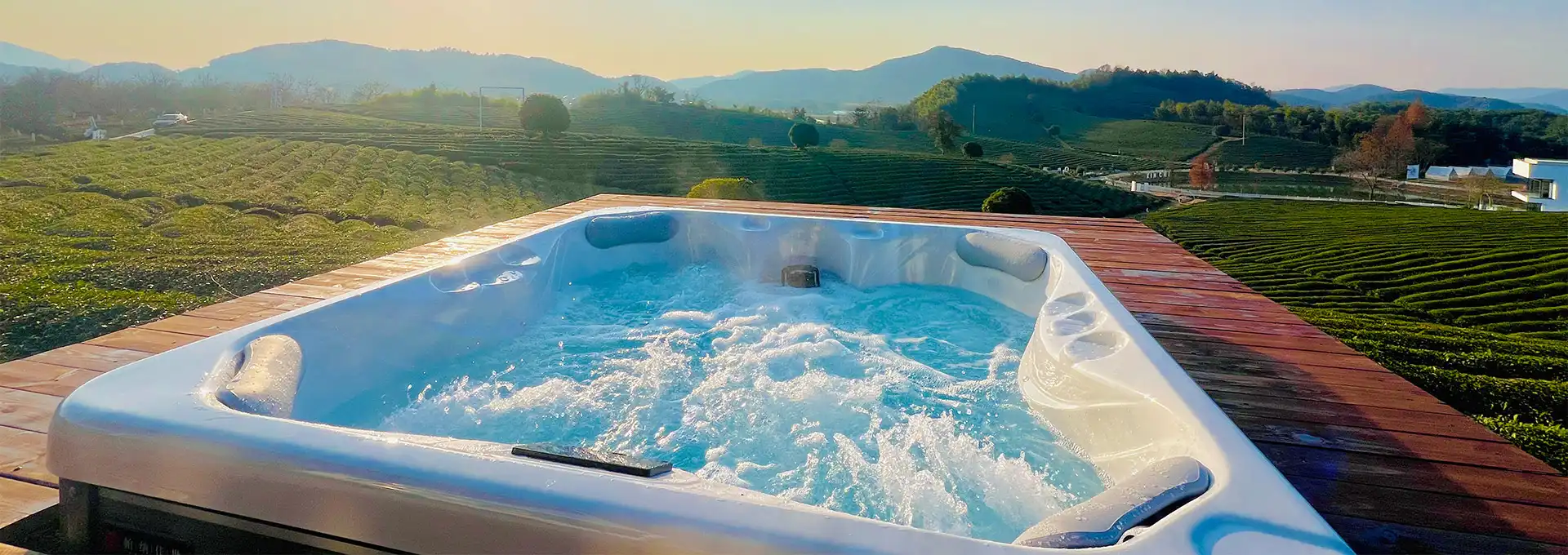Can I Drain My Hot Tub and Leave It Empty?
2024-11-16 15:52:57
Hot tub owners often wonder if it's safe to drain their hot tub and leave it empty, especially during periods of non-use or when preparing for maintenance. While it's possible to drain your hot tub, leaving it empty for extended periods can lead to various issues. This article will explore the implications of draining your hot tub, provide guidance on proper draining procedures, and discuss alternative options for maintaining your hot tub during periods of inactivity.
How long can you leave a hot tub empty?
The duration for which you can safely leave a hot tub empty depends on several factors, including the type of hot tub, its construction materials, and environmental conditions. Generally, it's not recommended to leave a hot tub empty for extended periods, as this can lead to various problems.
For most hot tubs, it's safe to leave them empty for a few days to a week, especially if you're performing routine maintenance or cleaning. However, leaving a hot tub empty for longer periods can result in the following issues:
- Drying and cracking of seals and gaskets
- Warping or damage to the shell, especially in extreme temperatures
- Accumulation of dust, debris, and potential pest infestations
- Damage to the plumbing system due to lack of water circulation
If you need to leave your hot tub empty for an extended period, it's crucial to take proper precautions. These may include:
- Thoroughly cleaning and drying the tub before emptying
- Covering the tub with a well-fitted, weather-resistant cover
- Ensuring proper ventilation to prevent moisture buildup
- Protecting the tub from extreme temperatures and direct sunlight
- Periodically checking the tub for any signs of damage or pest activity
If you plan to leave your hot tub empty for more than a few weeks, it's advisable to consult with a professional or refer to your manufacturer's guidelines for specific recommendations tailored to your hot tub model.
What happens if you don't put water in a hot tub?
Failing to maintain proper water levels in your hot tub can lead to a range of problems that may compromise its functionality and longevity. When a hot tub is left without water, several issues can arise:
- Damage to mechanical components: The pump, heater, and other mechanical parts of your hot tub are designed to operate while submerged in water. Running these components without water can cause severe damage, potentially leading to costly repairs or replacements.
- Seal and gasket deterioration: The seals and gaskets in your hot tub rely on moisture to remain pliable and effective. When left dry for extended periods, these components can crack, shrink, or become brittle, leading to leaks when the tub is refilled.
- Shell damage: The shell of your hot tub, particularly if it's made of acrylic or fiberglass, can become stressed and potentially crack or warp when left empty, especially in areas with extreme temperature fluctuations.
- Plumbing issues: The plumbing system in your hot tub is designed to be filled with water. When left empty, residual water in the pipes can stagnate, leading to bacterial growth or the formation of biofilm. Additionally, air can enter the system, potentially causing airlocks when you refill the tub.
- Pest infestations: An empty hot tub can become an attractive nesting site for various pests, including rodents and insects. These infestations can cause damage to the tub's components and create unsanitary conditions.
- UV damage: If your hot tub is exposed to direct sunlight while empty, the UV rays can cause fading, discoloration, or degradation of the shell material.
To avoid these issues, it's crucial to maintain proper water levels in your hot tub, even during periods of inactivity. If you need to drain your hot tub for maintenance or cleaning, try to minimize the time it remains empty. When refilling, be sure to follow the manufacturer's guidelines for proper water chemistry and startup procedures.
If you must leave your hot tub empty for an extended period, consider taking the following precautions:
- Use a high-quality, well-fitted cover to protect the tub from debris, pests, and UV radiation
- Ensure proper ventilation to prevent moisture buildup and mold growth
- Periodically check the tub for any signs of damage or pest activity
- Consider using a dehumidifier in the area to control moisture levels
- Consult with a professional about winterizing procedures if you live in an area with freezing temperatures
By understanding the potential consequences of leaving your hot tub without water and taking appropriate preventive measures, you can help ensure the longevity and proper functioning of your hot tub investment.
Is it OK to leave a hot tub empty in winter?
Leaving a hot tub empty during winter can be particularly risky, especially in regions that experience freezing temperatures. While it may seem like a good idea to drain your hot tub to prevent water from freezing and causing damage, an empty hot tub can actually be more susceptible to winter-related issues. Here's why it's generally not recommended to leave your hot tub empty during winter and what you should do instead:
Risks of Leaving a Hot Tub Empty in Winter
- Freezing damage: Any residual water left in the plumbing, pumps, or other components can freeze and expand, potentially causing cracks or bursts in the pipes and equipment.
- Shell contraction: Extreme cold can cause the hot tub shell to contract, potentially leading to cracks or structural damage, especially if the tub is made of acrylic or fiberglass.
- Seal deterioration: The cold, dry air can cause seals and gaskets to become brittle and crack, leading to leaks when the tub is refilled.
- Pest intrusion: An empty hot tub can become an attractive shelter for small animals seeking warmth during winter, potentially leading to damage or unsanitary conditions.
- Moisture accumulation: Despite being empty, an uncovered hot tub can accumulate snow or ice, which can lead to moisture-related issues such as mold or mildew growth.
Proper Winter Maintenance for Hot Tubs
Instead of leaving your hot tub empty during winter, consider the following options:
- Keep the hot tub running: The best option is to keep your hot tub filled and running throughout the winter. Modern hot tubs are designed to operate efficiently in cold weather, and the continuous circulation of warm water helps prevent freezing.
- Lower the temperature: If you don't plan to use the hot tub frequently during winter, you can lower the temperature to around 80-90°F (27-32°C) to reduce energy costs while still preventing freezing.
- Use a floating de-icer: For added protection against freezing, you can use a floating de-icer, which activates when water temperature approaches freezing point.
- Maintain proper water chemistry: Continue to test and adjust your water chemistry regularly, as proper chemical balance helps protect your hot tub's components.
- Use a high-quality cover: Invest in a well-insulated, tight-fitting cover to retain heat and prevent snow or debris from entering the tub.
- Insulate exposed pipes: If you have any exposed plumbing, wrap the pipes with insulation to provide extra protection against freezing.
Winterizing as an Alternative
If you absolutely must leave your hot tub empty during winter, proper winterization is crucial. This process typically involves:
- Draining the tub completely
- Blowing out all water from the plumbing lines using a wet-dry vacuum or air compressor
- Removing and storing the pump and heater in a warm, dry place
- Adding non-toxic antifreeze to the plumbing lines (following manufacturer guidelines)
- Cleaning and drying the tub thoroughly
- Covering the tub with a well-fitted, insulated cover
It's important to note that winterizing can be a complex process, and improper winterization can lead to significant damage. If you're not confident in your ability to winterize your hot tub correctly, it's best to consult a professional.
In conclusion, while it's possible to leave a hot tub empty in winter, it's generally not recommended due to the potential risks involved. Keeping your hot tub filled and running, even at a lower temperature, is usually the safest and most efficient way to protect your investment during the cold months. If you must leave it empty, proper winterization is essential to prevent damage and ensure your hot tub is ready for use when warmer weather returns.
For more information on hot tub installations and our products, please feel free to contact us at info@iparnassus.com.
References
- Hot Tub Works. "Can You Leave a Hot Tub Empty?"
- Swim University. "How to Drain and Clean a Hot Tub Properly"
- Hot Spring Spas. "How to Winterize Your Hot Tub"
- Caldera Spas. "Hot Tub Maintenance Tips"
- Bullfrog Spas. "How to Drain a Hot Tub"
- Master Spas. "Hot Tub Winterization Guide"
- The Spruce. "How to Winterize an Above Ground Pool or Hot Tub"
- Dimension One Spas. "Hot Tub Maintenance Tips"
- Jacuzzi. "Hot Tub Maintenance 101"
- Aqua Magazine. "Winterizing Pools and Spas"
Send Inquiry
Related Industry Knowledge
- Boosting Guest Retention with High-Quality Hot Tubs in Middle Eastern Hotels
- Can a Heart Patient Get in a Hot Tub?
- How to Cool a Hot Tub?
- How Many Gallons of Water in a Swim Spa?
- Does Hot Tub Wiring Need to Be Buried?
- What is a hot tub
- Is Spa Manufacturers Swim Spa Made of Fiberglass or Acrylic?
- How Large is a 6 Person Hot Tub?
- Can Getting in a Hot Tub Clear Your Sinus?
- Are Jacuzzi Hot Tubs Good For You?



